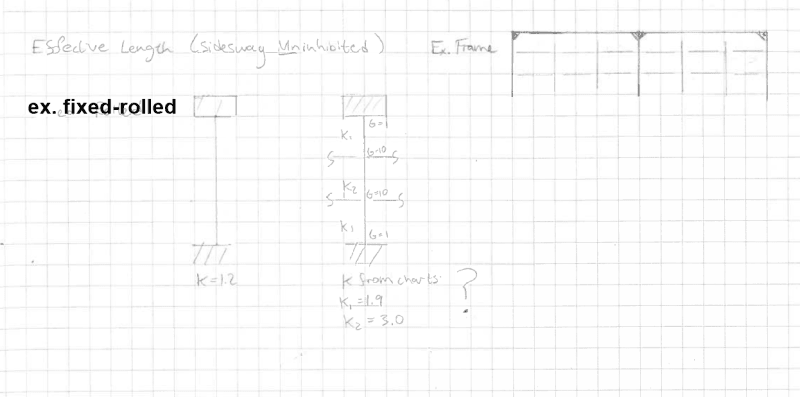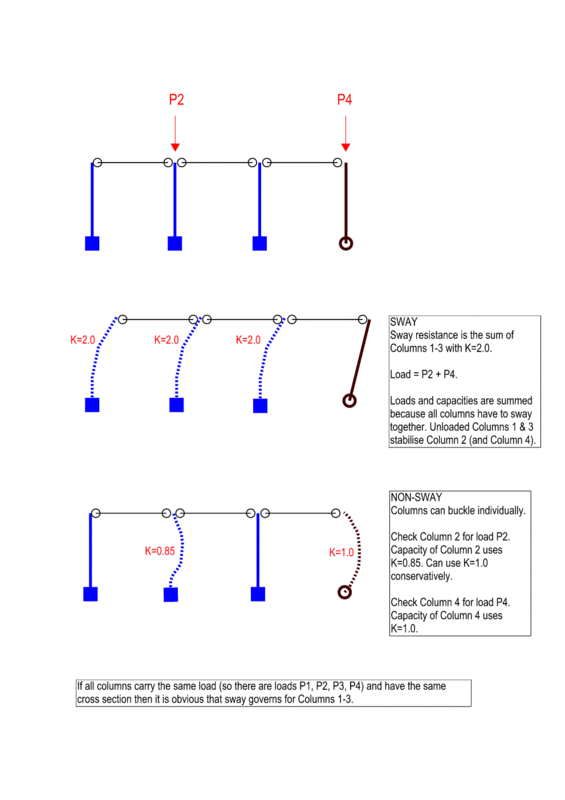Smoulder said:
If the moment frames are good enough to prevent sway buckling then you have to check each column for non-sway buckling with K<=1.0 and each column's own load.
This is perhaps poorly worded in an attempt to be all-inclusive.
You would not normally check the gravity columns for K<1.0. You'd check them for
K=1.0 (or the equivalent treatment in the current code). They are pinned-pinned. If they had a K less than one, they'd be moment connected top and/or bottom and would have a K>1 because they'd become part of the lateral system. K less than one is for fairly unusual situations involving braced elements that have unusual fixity at the top and/or bottom. Relatively few designs consider the base to be fixed, unless we are talking about cantilever columns, and cantilever columns are the lateral system at least partly if not totally (think most gas station canopies), and should not have a K=1. K should be greater than one due to the lack of bracing and the column is able to sway.
Smoulder said:
If you use notional loads and non-linear analysis then you don't have to use K>1.0 but check your code allows this. This is because the K>1.0 check accounted for the analysis giving bending moments that are too small because structure imperfections were ignored.
"structure imperfections" isn't really what's being dealt with here, or I feel compelled to quibble or be pedantic. This is perhaps arguably true, but it's a question of emphasis, as it's not a primary objective of the direct analysis. The P-small delta and the overall column compression tables account for residual stress and they account for some initial imperfections in the member. They probably account for some out of plumb, as well, due to erection tolerances. B
1/B
2 was a way to create an approximate second order analysis from a first order analysis, including K factors (after the fact, as a "post-processing" mostly manual check of the member to confirm the design worked after the analysis), to account for structural movement (under load cases), that a first order analysis did not capture (as well as account for some effect of softening of the structure due to column plastification when under [primarily] high axial loads). Keep in mind a true B
1/B
2 would include artificial restraints on the no-translation model (to get the M
nt (no translation) moments), and two separate analysis runs, that you then manually combine, with B
1/B
2 to determine the column is acceptable. I don't think anybody ever coded this and I'm not aware of a software at the time that would do it, at least not automatically because you have to appropriately restrain the frame to prevent lateral translation.
The advanced analysis is intended to (speaking from recall) "eliminate" K factor consideration by implicitly accounting for destabilization of the column due to structural movement (i.e. second order analysis (Generally this implies multiple load steps, calculating deflections, and iterating "upward", including P-large delta, P-small delta (geometric stiffness), story drift, there's also provision for plastification in the analysis and the more sophisticated analysis engines should have a way to "step back" if a load step goes "too far" beyond the failure surface on a column so that the column stays "on" the failure surface, as of say 2000 this was a bit of a computational mess, if you ask me, I know I had a lot of trouble dealing with the failure surface coding) directly, so the K factor is still "there" so to speak, but it's not explicitly calculated, you can back calculate it if you are curious, as far as I know, if you have enough information from the software.
I had a class on advanced analysis ("direct analysis" in the current nomenclature) otherwise I wouldn't be wading into this discussion so pedantically. That class worked off the
Ron Ziemian Ph.D. thesis "
Advanced Methods of Inelastic Analysis in the Limit States Design of Steel Structures", (this is the current editor of the Stability Design Criteria for Metal Structures guide, I think). I still have that in the garage archive. The thesis, I mean.
Should anyone be interested the first 24 pages (no formulas) of the Dissertation is available through the link above.



